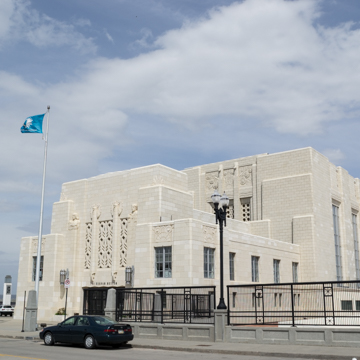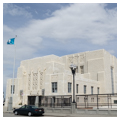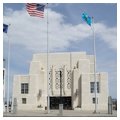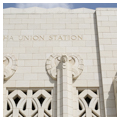You are here
The Durham Museum
Located on the southeast edge of downtown Omaha, Union Station is one of the largest structures in the Omaha Railroad Commerce Historic District and one of the earliest and finest art deco stations in the country. Once part of the Union Pacific system, it was designed by Gilbert Stanley Underwood of Los Angeles during his seven year tenure as the railroad’s consulting architect. Best known for his National Park lodges, Underwood designed seventeen Union Pacific depots between 1923 and 1930. The Omaha passenger station was his last.
This steel frame building is clad in cream-colored glazed terra-cotta. Its bold rectangular massing is animated by stepped setbacks, projecting and receding facade surfaces, stylized floral motifs, and ornamentation in geometric configurations. Sculptured figures depicting railroad personnel are located above the north and west entrances. The impressive main floor waiting room is sixty feet high and features a richly decorated ceiling, ten tall cathedral-style windows of stained glass flanked by marble columns, marble wainscoting, and terrazzo floor. Crystal and bronze chandeliers, weighing two thousand pounds each, both dominate and illuminate the waiting room. The original restaurant, now the Swanson Gallery, is located near the eastern end of the building and is decorated with six murals depicting stages in the development of transportation painted by Los Angeles artist Joseph W. Keller.
At mid-century the station served thousands of passengers each day and was the principle and critical regional link for the North Western, Rock Island, Milwaukee, Missouri Pacific, and Wabash railroads. Union Station closed in 1971, due to declining business. In 1973, the railroad donated the station to the City of Omaha and in 1975 it became Western Heritage Museum. Led by Margre and Charles Durham, a group of business leaders and philanthropists undertook the building’s renovation between 1995 and 1997. This work is most apparent in the former main waiting room, now the plaza level Suzanne and Walter Scott Great Hall. Meticulously restored, the lower level of the museum houses a variety of transportation and commerce exhibits including a steam locomotive and historic train cars.
In the late 1990s the museum was renamed in the Durhams’ honor and work was begun to expand the museum’s facilities for exhibitions and public programs. The Velde Gallery opened in 2004; the Stanley and Dorothy Truhlsen Lecture Hall in 2007. In 2008 it became simply the Durham Museum and remains an important institution dedicated to preserving and displaying local and regional history.
References
Kolberg, Persijs, “Union Passenger Terminal,” Douglas County, Nebraska. National Register of Historic Places Inventory-Nomination Form, 1971. National Park Service, U.S. Department of the Interior, Washington, DC.
Writing Credits
If SAH Archipedia has been useful to you, please consider supporting it.
SAH Archipedia tells the story of the United States through its buildings, landscapes, and cities. This freely available resource empowers the public with authoritative knowledge that deepens their understanding and appreciation of the built environment. But the Society of Architectural Historians, which created SAH Archipedia with University of Virginia Press, needs your support to maintain the high-caliber research, writing, photography, cartography, editing, design, and programming that make SAH Archipedia a trusted online resource available to all who value the history of place, heritage tourism, and learning.



















